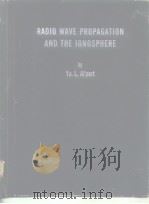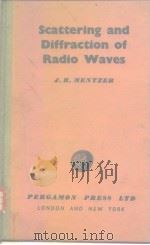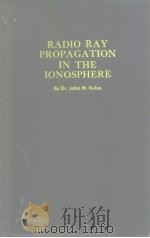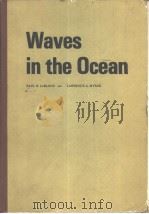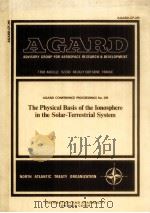《RADIO WAVES IN THE IONOSPHERE》
| 作者 | K.G.BUDDEN 编者 |
|---|---|
| 出版 | CAMBRIDGE AT THE UNIVERSITY PRESS |
| 参考页数 | 542 |
| 出版时间 | 1961(求助前请核对) 目录预览 |
| ISBN号 | 无 — 求助条款 |
| PDF编号 | 813353658(仅供预览,未存储实际文件) |
| 求助格式 | 扫描PDF(若分多册发行,每次仅能受理1册) |

CHAPTER 1.INTRODUCTION1
1.1The composition of the ionosphere1
1.2 Plane waves and spherical waves.The curvature of the earth1
1.3 Effect of collisions and of the earth's magnetic field2
1.4 Relation to other kinds of wave-propagation2
1.5 The variation of electron density with height.The Chapman layer3
1.6 Approximations to the electron density profile5
1.7 The variation of collision-frequency with height6
1.8 The structure of the ionosphere7
1.9 Horizontal variations and irregularities10
CHAPTER 2.THE BASIC EQUATIONS11
2.1Units11
2.2 Harmonic waves and complex quantities12
2.3 Definitions of electric intensity E and magnetic intensity H13
2.4 The current density J and electric polarisation P14
2.5 The electric displacement D and magnetic induction B15
2.6 Maxwell's equations16
2.7 Cartesian coordinate system16
2.8 Progressive plane waves17
2.9 Plane waves in free space19
2.10 The notation ?and H20
2.11 The energy stored in a radio wave in the ionosphere20
2.12 The flow of energy.Poynting's theorem21
2.13 The Poynting vector22
CHAPTER 3.THE CONSTITUTIVE RELATIONS24
3.1Introduction24
3.2 Free,undamped electrons24
3.3 Electron collisions.Damping of the motion25
3.4 Effect of the earth's magnetic field on motion of electrons26
3.5 The effect of the magnetic field of the wave on the motion of electrons28
3.6 The susceptibility matrix29
3.7 The Lorentz polarisation term30
3.8 The effect of small irregularities in the ionosphere31
3.9 The effect of heavy ions31
3.10 The energy stored in a radio wave in the ionosphere(continued)33
3.11 The principal axes35
CHAPTER 4.PROPAGATION IN A HOMOGENEOUS ISOTROPIC MEDIUM38
4.1Definition of the refractive index38
4.2 The Maxwell equation derived from Faraday's law38
4.3 Isotropic medium without damping39
4.4 Isotropic medium with collision damping40
4.5 The physical interpretation of a complex refractive index41
4.6 Evanescent waves41
4.7 Inhomogeneous plane waves42
4.8 Energy flow in inhomogeneous plane waves44
4.9 The case when X=1,n=045
CHAPTER 5.PROPAGATION IN A HOMOGENEOUS ANISOTROPIC MEDIUM.MAGNETOIONIC THEORY47
5.1Introduction47
5.2 The wave-polarisation47
5.3 The polarisation equation48
5.4 Properties of the polarisation equation49
5.5 Alternative measure of the polarisation.Axis ratio and tiltangle51
5.6 The Appleton-Hartree formula for the refractive index52
5.7 The longitudinal component of the electric field53
5.8 The flow of energy for a wave in amagnetoionic medium54
5.9 The effect of heavy ions on polarisation and refractive index56
Examples57
CHAPTER 6.PROPERTIES OF THE APPLETON-HARTREE FORMULA59
6.1General properties.Zeros and infinity of the refractive index59
6.2 Collisions neglected60
6.3 Frequency above the gyro-frequency60
6.4 Longitudinal propagation when Y<160
6.5 Transverse propagation when Y<161
6.6 Intermediate inclination of the field when Y<162
6.7 Frequency below the gyro-frequency64
6.8 Longitudinal propagation when Y>164
6.9 Transverse propagation when Y>165
6.10 Intermediate inclination of the field when Y>165
6.11 Effect of collisions included66
6.12 The critical collision-frequency67
6.13 Longitudinal propagation when collisions are included69
6.14 Transverse propagation when collisions are included70
6.15 Intermediate inclination of the field72
6.16 The'quasi-longitudinal'approximation76
6.17 The'quasi-transverse'approximation77
6.18 The effect of heavy ions78
CHAPTER 7.DEFINITION OF THE REFLECTION AND TRANSMISSION COEFFICIENTS85
7.1Introduction85
7.2 The reference-level for reflection coefficients85
7.3 The reference-level for transmission coefficients87
7.4 The four reflection coefficients and the four transmisson coefficients88
7.5 The sign convention88
7.6 The reflection coefficient matrix90
7.7 Alternative forms of the reflection coefficients90
7.8 Spherical waves91
Examples94
CHAPTER 8.REFLECTION AT A SHARP BOUNDARY96
8.1Introduction96
8.2 The boundary conditions96
8.3 Snell's law97
8.4 Derivation of the Fresnel formulae for isotropic media98
8.5 General properties of the Fresnel formulae100
8.6 The Fresnel formulae when the electric vector is in the plane of incidence101
8.7 The Fresnel formulae when the electric vector is horizontal105
8.8 Reflection when X=1,Z=0,n=0106
8.9 Normal incidence108
8.10 Homogeneous ionosphere with parallel boundsries108
8.11 Normal incidenceon a parallel-sided slab112
8.12 Reflection at normal incidence when the earth's magnetic field is allowed for114
8.13 Earth's magnetic field horizontal.Normal incidence115
8.14 Earth's magnetic field vertical.Normal incidence116
8.15 Reflection when the earth's magnetic field is included.Approximate formulae for oblique incidence116
8.16 The validity of the approximations119
8.17 Reflection at oblique incidence.The Booker quartic120
8.18 Some properties of the Booker quartic123
8.19 Reflection at oblique incidence for north-south or south-north propagation124
8.20 Reflection at oblique incidence in the general case126
Examples127
CHAPTER 9.SLOWLY VARYING MEDIUM.THE W.K.B.SOLUTIONS128
9.1Introduction128
9.2 The differential equations128
9.3 The phase memory concept130
9.4 Loss-free medium.Constancy of energy-flow131
9.5 Derivation of the W.K.B.solution131
9.6 Condition for the validity of the W.K.B.solutions133
9.7 Properties of the W.K.B.solutions134
9.8 The reflection coefficient136
9.9 Coupling between upgoing and downgoing waves137
9.10 Extension to oblique incidence138
9.11 The differential equations for oblique incidence140
9.12 The W.K.B.solutions for horizontal polarisation at oblique incidence140
9.13 The W.K.B.solutions at oblique incidence when the electric vector is parallel to the plane of incidence142
9.14 The effect of including the earth's magnetic field143
9.15 Ray theory and'full wave'theory144
CHAPTER 10.RAY THEORY FOR VERTICAL INCIDENCE WHEN THE EARTH'S MAGNETIC FIELD IS NEGLECTED146
10.1The use of pulses146
10.2 The group velocity147
10.3 The equivalent height of reflection h′(f)149
10.4 The'true height'and the'phase height'150
10.5 The equivalent height of reflection for a linear profile of electron density150
10.6 The equivalent height of reflection for an exponential variation of electron density151
10.7 Equivalent height for a parabolic profile of electron density152
10.8 Equivalent height for the'sech2'profile of electron density156
10.9 Two separate parabolic layers157
10.10 The effect of a'ledge'in the electron density profile158
10.11 The calculation of electron density N(z),from h′(f)data160
10.12 Solution when N(z)is monotonic161
10.13 Partial solution when N(z)is not monotonic163
10.14 The shape of apulse of radiowaves166
10.15 The effect of electron collisions on group refractive index170
10.16 The effect of collisions on equivalent height h′(f)and phase height h(f)171
10.17 Relation between equivalent height,phase height and absorption172
Examples174
CHAPTER 11.RAY THEORY FOR OBLIQUE INCIDENCE WHEN THE EARTH'S MAGNETIC FIELD IS NEGLECTED175
11.1Introduction.The ray path175
11.2 Wave-packets177
11.3 The equation for the ray when the earth's magnetic field is neglected178
11.4 The ray path for a linear gradient of electron density179
11.5 The ray path for exponential variation of electron density180
11.6 The ray path for a parabolic profile of electron density182
11.7 The skip distance183
11.8 The equivalent path P′ at oblique incidence185
11.9 Breit and Tuve's theorem.Martyn's theorem for equivalent path186
11.10 The equivalent path at oblique incidence for a linear gradient of electron density188
11.11 The equivalent path at oblique incidence for a parabolic profile of electron density188
11.12 The dependence of signal on frequency near the maximum usable frequency190
11.13 The prediction of maximum usable frequencies.Appleton and Beynon's method191
11.14 The curvature of the earth192
11.15 The prediction of maximum usable frequencies.Newbern Smith's method194
11.16 The absorption of radio waves.Martyn's theorem for absorption195
11.17 The effect of electron collisions on equivalent path197
Examples197
CHAPTER 12.RAY THEORY FOR VERTICAL INCIDENCE WHEN THE EARTH'S MAGNETIC FIELD IS INCLUDED199
12.1Introduction199
12.2 Magnetoionic'splitting'199
12.3 The group refractive index—collisions neglected200
12.4 The effect of collisions on the group refractive index204
12.5 The equivalent height of reflection h′(f)—collisions neglected205
12.6 The h′(f)curves when collisions are neglected206
12.7 The penetration-frequencies for the ordinary and extraordinary waves208
12.8 The equivalent height for a parabolic layer209
12.9 Two separate parabolic layers210
12.10 The effect of a'ledge'in the electron density profile212
12.11 The effect of collisions on equivalent height h′(f)212
12.12 The polarisation of waves in a wave-packet214
12.13 The calculation of electron density N(z)from h′(f)215
12.14 Example of the use of the method218
12.15 Other versions of the foregoing method221
12.16 Failure of the method when N(z)is not monotonic222
12.17 Theuse of h′x(f)for the extraordinary ray223
Example224
CHAPTER 13.RAY THEORY FOR OBLIQUE INCIDENCE WHEN THE EARTH'S MAGNETIC FIELD IS INCLUDED225
13.1Introduction225
13.2 The variable q225
13.3 Derivain of the Booker quartic226
13.4 The transition to a continuous medium228
13.5 The path of a wave-packet229
13.6 The reversibility of the path230
13.7 The reflection of a wave-packet230
13.8 A simple example of ray paths at oblique incidence231
13.9 Further properties of the Booker quartic233
13.10 The Booker quartic for east-west and west-east propagation236
13.11 The Booker quartic for north-south and south-north propagation238
13.12 The Booker quartic in the general case when collisions are neglected244
13.13 Lateral deviation at vertical incidence246
13.14 Lateral deviation for propagation from(magnetic)east to west or west to east248
13.15 Lateral deviation in the general case250
13.16 Calculation of attenuation,using the Booker quartic250
13.17 The'refractive index'surface in a homogeneous medium252
13.18 The direction of the ray253
13.19 The ray velocity and the ray surface255
13.20 Whistlers256
13.21 Determination of ray direction by Poeverlein's construction258
13.22 Propagation in the magnetic meridian.The'Spitze'260
13.23 The refractive index surfaces for the extraordinary ray when Y<1262
13.24 The refractive index surfaces for the extraordinary ray when Y>1266
13.25 The second refractive index surface for the ordinary ray when Y>1268
Examples270
CHAPTER 14.THE GENERAL PROBLEM OF RAY TRACING271
14.1Introduction271
14.2 Equations of the refractive index surface and the ray surface272
14.3 The Eikonal function274
14.4 The canonical equations for a ray,and the generalisation of Snell's law276
14.5 Other relations between the equations for the ray surface and the refractive index surface278
14.6 Fermat's principle279
14.7 Equivalent path and absorption279
14.8 The problem of finding the maximum usable frequency281
Examples282
CHAPTER 15.THE AIRY INTEGRAL FUNCTION,AND THE STOKES PHENOMENON283
15.1Introduction283
15.2 Linear gradient of electron density associated with an isolated zero of q283
15.3 The differential equation for horizontal polarisation and oblique incidence285
15.4 The Stokes differential equation286
15.5 Qualitative discussion of the solutions of the Stokes equation287
15.6 Solutions of the Stokes equation expressed as contour integrals288
15.7 Solutions of the Stokes equation expressed as Bessel functions291
15.8 Tables of the Airy integral functions291
15.9 The W.K.B.solutions of the Stokes equation292
15.10 The Stokes phenomenon of the'discontinuity of the constants'292
15.11 Stokes lines and anti-Stokes lines293
15.12 The Stokes diagram294
15.13 Definition of the Stokes constant295
15.14 Furry's derivation of the Stokes constants for the Stokes equation296
15.15 Asymptotic approximations obtained from the contour integrals297
15.16 Summary of some important properties of complex variables297
15.17 Integration by the method of steepest descents300
15.18 Application of the method of steepest descents to solutions of the Stokes equation302
15.19 Integration by the method of stationary phase307
15.20 Method of stationary phase applied to the Airy integral function309
15.21 Asymptotic expansions310
15.22 The range of validity of asymptotic approximations310
15.23 The choice of a fundamental system of solutions of the Stokes equation312
15.24 Connection formulae,or circuit relations313
15.25 The intensity of light neara caustic313
CHAPTER 16.LINEAR GRADIENT OF ELECTRON DENSITY319
16.1Introduction319
16.2 Purely linear profile.Electron collisions neglected319
16.3 Application to a slowly varying profile322
16.4 The effect of electron collisions.The height z as a complex variable326
16.5 Constant collision-frequency.Purely linear profile of electron density327
16.6 The slowly varying profile when collisions are included.Derivation of the phase integral formula329
16.7 Discussion of the phase integral formula331
16.8 Effect of curvature of the electron density profile333
16.9 Reflection at a discontinuity of gradient334
16.10 Linear gradient between two homogeneous regions336
16.11 Symmetrical ionosphere with double linear profile340
16.12 The differential equation for oblique incidence applicable when the electric vector is parallel to the plane of incidence343
16.13 The behaviour of the fields near a zero of the refractive index for'vertical'polarisation at oblique incidence346
16.14 The generation of harmonics in the ionosphere347
16.15 The phase integral formula for'vertical'polarisation at oblique incidence348
16.16 Asymptotic approximations for the solutions of the differential equation for'vertical'polarisation349
16.17 Application of the phase integral formula350
CHAPTER 17.VARIOUS ELECTRON DENSITY PROFILES WHEN THE EARTH'S MAGNETIC FIELD IS NEGLECTED353
17.1Introduction353
17.2 Exponential profile.Constant collision-frequency354
17.3 The phase integral formula applied to the exponential layer357
17.4 The parabolic layer358
17.5 Partial penetration and reflection363
17.6 The equivalent height of reflection for a parabolic layer365
17.7 Electron density with square law increase366
17.8 The sinusoidal layer368
17.9 Circuit relations.Introduction to Epstein's theory369
17.10 The hypergeometric differential equation370
17.11 The circuit relations for the hypergeometric function372
17.12 Application to the wave-equation375
17.13 The reflection and transmission coefficients of an Epstein layer377
17.14 Epstein profiles378
17.15 Ionosphere with gradual boundary380
17.16 The'sech2'profile380
17.17 Fixed electron density and varying collision-frequency383
CHAPTER 18.ANISOTROPIC MEDIA.COUPLED WAVE-EQUATIONS AND W.K.B.SOLUTIONS385
18.1Introduction385
18.2 The differential equations385
18.3 The four characteristic waves387
18.4 Matrix form of the equations389
18.5 The differential equations for vertical incidence391
18.6 The W.K.B.solution for vertical incidence on a loss-free medium392
18.7 Introduction to W.K.B.solutions in the general case394
18.8 Introduction to coupled wave-equations394
18.9 F?rsterling's coupled equations for vertical incidence396
18.10 Coupled equations in the general case,in matrix form398
18.11 Expressions for the elements of S,S-1,and -S-1S′399
18.12 The W.K.B.solutions in the general case401
18.13 The first-order coupled equations for vertical incidence402
18.14 The W.K.B.solutions for vertical incidence405
18.15 The first-order equations in other special cases406
18.16 Second-order coupled equations408
18.17 Condition for the validity of the W.K.B.solutions410
Example411
CHAPTER 19.APPLICATIONS OF COUPLED WAVE-EQUATIONS412
19.1Introduction412
19.2 Properties of the coupling parameter ψ412
19.3 Behaviour of the coefficients near a coupling point417
19.4 Properties of the coupled differential equations near a reflection point and near a coupling point418
19.5 The use of successive approximations421
19.6 The phase integral formula for coupling423
19.7 The Z-trace424
19.8 The method of'variation of parameters'426
19.9 The'coupling echo'428
19.10 The transition through critical coupling429
19.11 Introduction to limiting polarisation432
19.12 The free space below the ionosphere433
19.13 The differential equation for the study of limiting polarisation434
Examples436
CHAPTER 20.THE PHASE INTEGRAL METHOD437
20.1Introduction437
20.2 The Riemann surface for the refractive index438
20.3 The linear electron density profile440
20.4 The parabolic electron density profile443
20.5 A further example of the method446
20.6 Coupling branch points and their Stokes lines and anti-Stokes lines450
20.7 The phase integral method for coupling452
20.8 Further discussion of the transition through critical coupling(continued from§19.10)455
Example457
CHAPTER 21.FULL WAVE SOLUTIONS WHEN THE EARTH'S MAGNETIC FIELD IS INCLUDED458
21.1Introduction458
21.2 The differential equations458
21.3 Vertical incidence and vertical magnetic field459
21.4 Exponential profile of electron density.Constant collision-frequency460
21.5 Exponential profile(continued).Incident wave linearly polarised462
21.6 Other electron density profiles for vertical field and vertical incidence464
21.7 Vertical magnetic field and oblique incidence.Introduction to Heading and Whipple's method464
21.8 Regions O,Ⅰ and Ⅰ(a)465
21.9 Reflection and transmission coefficients of region Ⅰ467
21.10 Regions Ⅱ and Ⅱ(a)468
21.11 The reflection coefficients of region Ⅱ469
21.12 The combined effect of regions Ⅰ and Ⅱ471
21.13 The effect of an infinity in the refractive index472
21.14 Isolated infinity of refractive index474
21.15 Refractive index having infinity and zero476
21.16 The apparent loss of energy near an infinity of refractive index479
Example481
CHApTER 22.NUMERICAL METHODS FOR FINDING REFLECTION COEFFICIENTS482
21.1Introduction482
22.2 Methods of integrating differential equations483
22.3 The size of the step484
22.4 The choice of dependent variable484
22.5 The three parts of the calculation of reflection coefficients486
22.6 The starting solutions at a great height487
22.7 Calculation of the components of the reflection coefficient489
22.8 The wave-admittance in an isotropic ionosphere491
22.9 The wave-admittance matrix A for an anisotropic ionosphere493
22.10 The starting value of A495
22.11 Relation between the admittance matrix A and the reflection coefficient matrix R496
22.12 The differential equation for A498
22.13 Symmetry properties of the differential equations499
22.14 Equivalent height of reflection499
Example501
CHAPTER 23.RECIPROCITY502
23.1Introduction502
23.2 Aerials502
23.3 Goubau's reciprocity theorem505
23.4 One magnetoionic component506
23.5 Reciprocity with full wave solutions508
Appendix.The Stokes constant for the differential equation(16.98)for'vertical'polarisation510
Bibliography512
Index of definitions of the more important symbols525
Subject and name index530
1961《RADIO WAVES IN THE IONOSPHERE》由于是年代较久的资料都绝版了,几乎不可能购买到实物。如果大家为了学习确实需要,可向博主求助其电子版PDF文件(由K.G.BUDDEN 1961 CAMBRIDGE AT THE UNIVERSITY PRESS 出版的版本) 。对合法合规的求助,我会当即受理并将下载地址发送给你。
高度相关资料
-
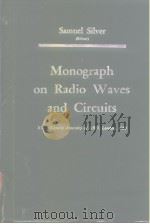
- Monograph on radio waves and circuits;Interntional scientific radio union.commission VI on radio wav
-
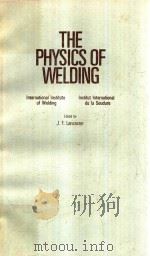
- THE PHYSICS OF WELDING
- 1984 PERGAMON PRESS
-

- FROM FAILING BODIES TO RADIO WAVES
- 1984 W. H. FREEMAN AND CO
-
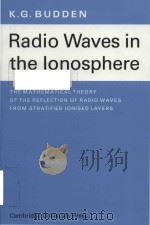
- Radio waves in the ionosphere the mathematical theory of the reflection of radio waves from stratifi
- 1961 University Press
-
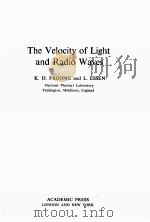
- THE VELOCITY OF LIGHT AND RADIO WAVES
- 1969 ACADEMIC PRESS
-

- RADIO WAVES IN THE IONOSPHERE
- 1961 CAMBRIDGE AT THE UNIVERSITY PRESS
-

- FORSCHUNGS-FELD WELTRAUM
- 1978 TRANSPRESS VEB VERLAG FUR VERKEHRSWESEN
提示:百度云已更名为百度网盘(百度盘),天翼云盘、微盘下载地址……暂未提供。➥ PDF文字可复制化或转WORD

